Unha com fungo ou psoríase nas unhas?
How Nail Pros Can Spot the Difference between Fungal Nail and Nail Psoriasis… and when to Refer
As a nail professional, your clients trust you to notice changes in their nails, and you’re often the first to spot signs of something unusual. Two of the most commonly confused conditions are fungal nail infections and nail psoriasis. Both can cause discolouration, thickening, and unha escamosa mas exigem abordagens muito diferentes.
Knowing what to look for and when to refer to a podiatrist can make a big difference to your clients’ nail health.
O que é uma infecção fúngica nas unhas?
Uma infecção fúngica das unhas (também conhecida como onicomicose) is caused by a buildup of dermatophyte mould fungi that invade the nail plate, the skin underneath it (the nail bed) or any or all of the skin of the foot itself. These organisms thrive in warm, moist environments and often begin by infecting the skin between the toes (athlete’s foot) before spreading to the toenails.
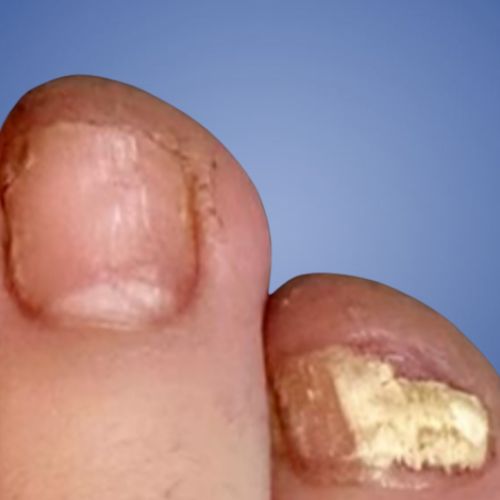
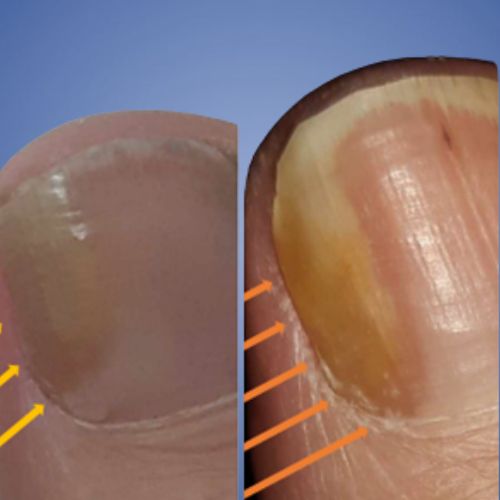
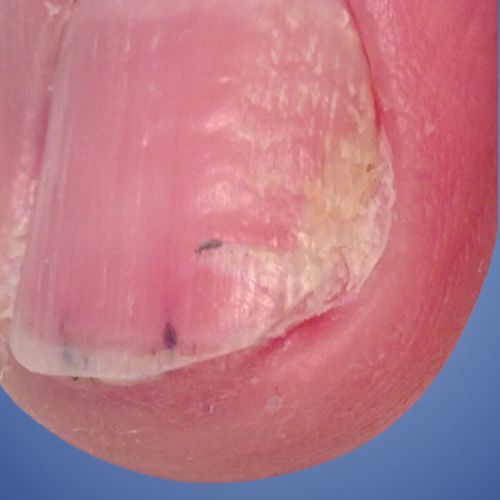
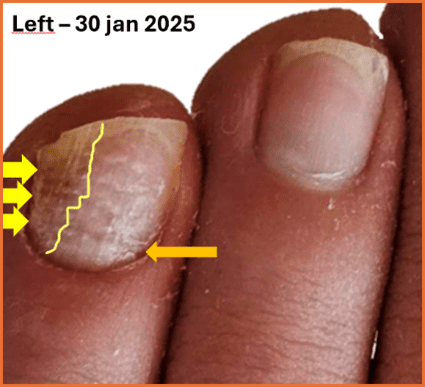
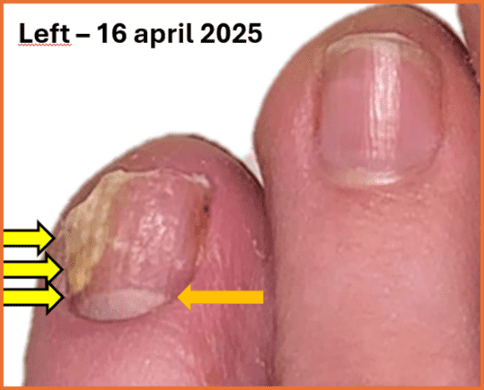
Fig. D1 e Fig. D2: Looks like Psoriasis – It was tested and it’s a fungal infection but in this case, it could also be Psoriatic!
Fungal infections are contagious and can spread through shared footwear, nail tools, or damp environments like swimming pools, gyms and even your shower at home. Although a fungal infection can affect one or multiple nails, it may slowly worsen over time without treatment. You don’t have to be old to get one as fungal infections are often seen in young footballers or runners, the reason for this is damage to the unidade de pregos durante a corrida ou jogo, geralmente um minitrauma de algum tipo que dá aos fungos a chance de se enraizarem, mas até mesmo calçados muito pequenos podem causar uma abertura na placa ungueal onde os fungos podem se instalar.
O que é psoríase das unhas?
A psoríase é uma doença inflamatória da pele de longa duração que também pode afetar uma ou todas as partes da unhas. Na psoríase ungueal, o sistema imunológico acelera a produção de células da pele ao redor e sob a unha, levando ao acúmulo de células e ao crescimento anormal da unha.
A psoríase das unhas é não contagiosoA psoríase é uma doença degenerativa, mas pode ser angustiante e causar desconforto ou alterações na aparência das unhas. Pode afetar apenas as unhas ou fazer parte de sintomas mais amplos de psoríase na pele ou até mesmo nas articulações (artrite psoriática).
Como são as infecções fúngicas das unhas
As infecções fúngicas das unhas geralmente começam na ponta ou na lateral da unha e se espalham lentamente.
Sinais comuns:
- Descoloração amarela, marrom ou branca
- Fragmentado ou unha quebradiça bordas
- Unhas espessadas
- Levantamento da unha do leito ungueal (onicólise)
- Detritos escamosos sob a unha
- Um cheiro de mofo ou desagradável
Frequentemente vinculado a:
- Trauma nas unhas
- Uso de calçados apertados, não respiráveis ou mal ajustados
- Athlete’s foot (tinea pedis)
- Andar descalço em áreas comuns
- Compartilhamento de ferramentas para unhas
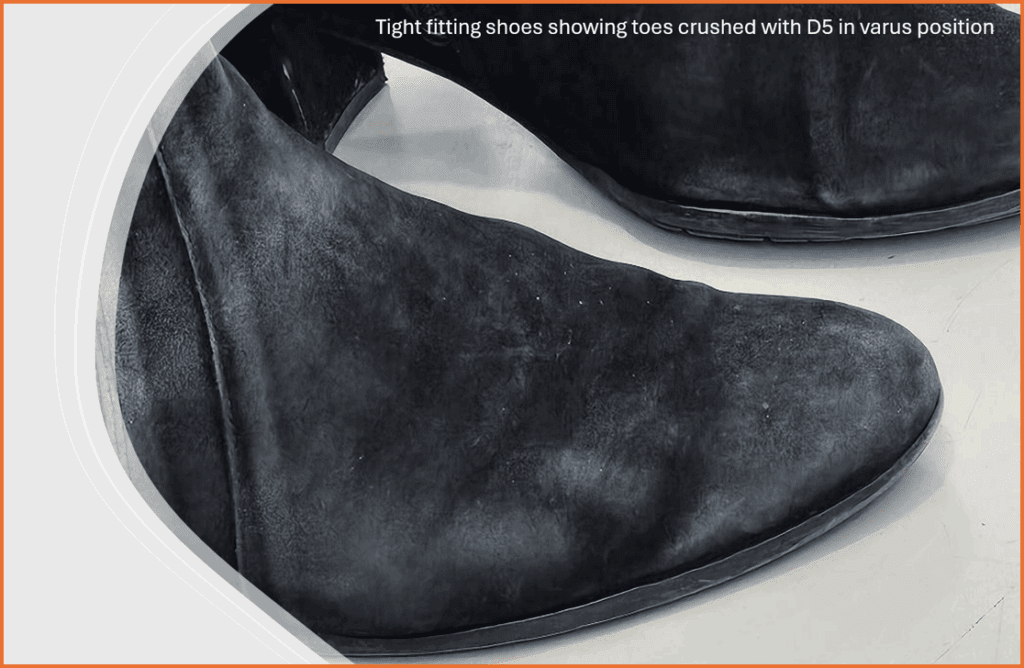
Como é a psoríase das unhas
A psoríase das unhas pode afetar todas as partes da unha ou partes separadas dela matriz de unhas (which forms the nail plate) or the nail bed (beneath the nail). It can appear even if the client doesn’t have visible psoriasis on the skin.
Sinais comuns:
- Pequenos buracos (amassados minúsculos) na placa ungueal
- A salmon-pink “oil drop” patch under the nail
- Ranhuras ou sulcos ao longo da unha
- Thickened skin under the nail (subungual hyperkeratosis)
- Manchas brancas ou hemorragias por estilhaços
- Unhas que se levantam do leito ungueal, geralmente em várias unhas
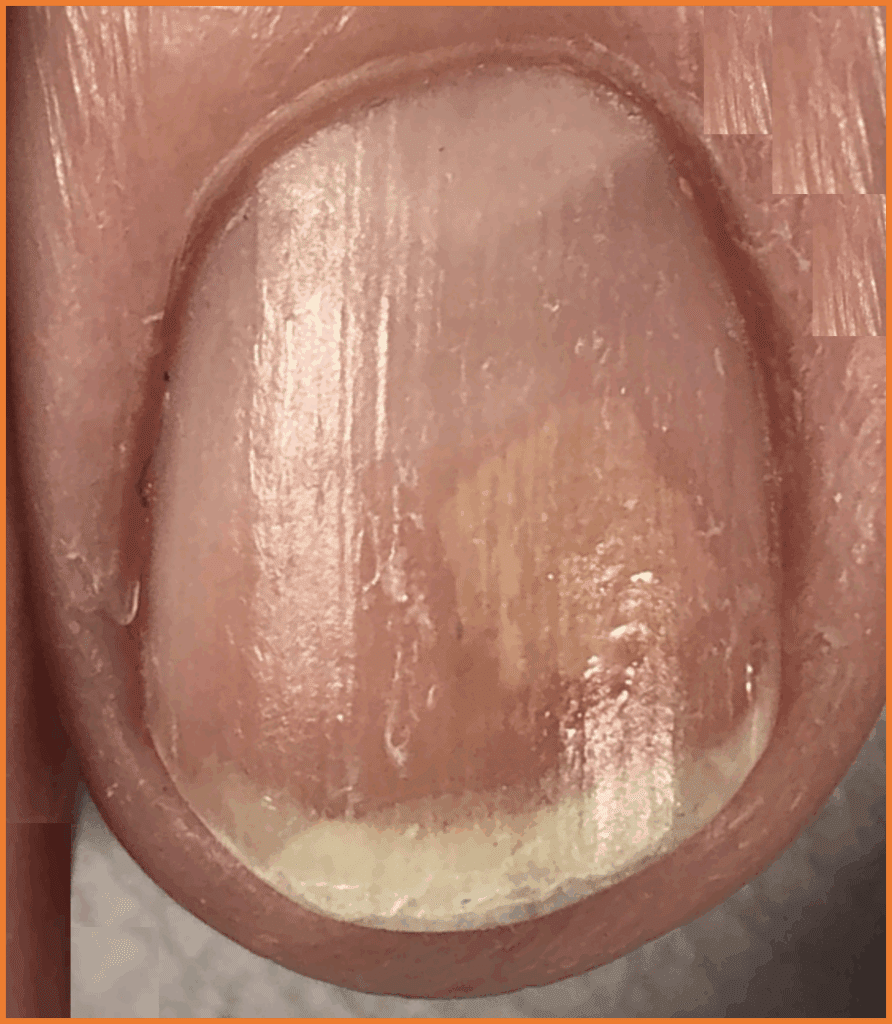
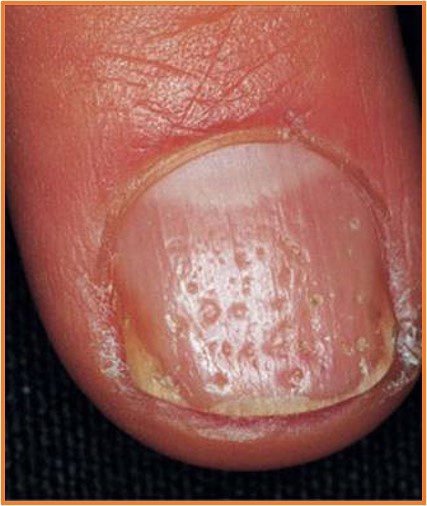
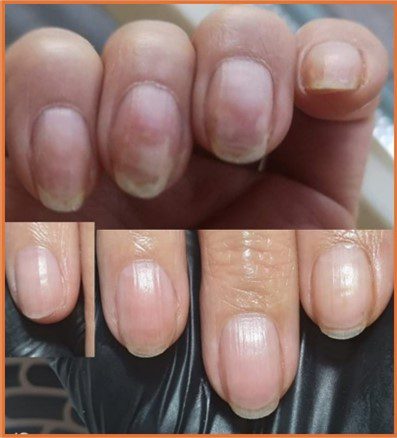
As alterações psoriásicas nas unhas geralmente são simétricas e podem afetar uma ou várias unhas ao mesmo tempo.
Por que é importante
Essas duas condições podem parecer muito semelhantes, mas as causas e os tratamentos são completamente diferentes. It’s impossible to diagnose either with just the eye – Fungal infections can only be properly diagnosed with a test – Psoriasis needs to be diagnosed by a Dermatologist.
Treating a fungal nail with antifungal won’t help if the problem is actually psoriasis. Likewise, treating nail psoriasis with topical steroids or an antifungal product won’t touch a fungal infection.
That’s why it’s essential to refer clients to a podiatrist if you see any persistent changes or signs of infection.
***Os testes podem excluir ou confirmar uma infecção fúngica.
Quando encaminhar seu cliente
Consulte um podólogo se seu cliente tiver:
- Dor, inchaço, sangramento ou sensibilidade ao redor da unha
- Unhas com mau cheiro ou que parecem infectadas
- Symptoms that aren’t improving after self-treatment
- Alterações em várias unhas, especialmente se elas parecerem simétricas
- Histórico pessoal ou familiar de psoríase ou problemas de pele
- Any unusual or concerning changes you’re unsure about
A podiatrist can take a nail sample, test for fungal infection, and make a clear diagnosis. They’ll also create a treatment plan tailored to your client’s needs.
Como você pode ajudar
You’re not expected to diagnose, but you são in the perfect position to notice early changes. Your trained eye, paired with good hygiene and proper referrals, plays a huge role in protecting your client’s well-being.
By referring to a podiatrist when something doesn’t seem right, you’re giving your clients the best care possible and helping them get the treatment they need sooner rather than later.
Pensamento final
Nail health is about more than just looks. Whether it’s fungus or psoriasis, catching it early can prevent long-term damage and give your client peace of mind. If something doesn’t look right, trust your instincts and refer to a podiatrist. You could be the first person to make a real difference in their health journey.
*** 1.Tsunemi Y, Takehara K, Miura Y, Nakagami G, Sanada H, Kawashima M. Screening for tinea unguium by Dermatophyte Test Strip. Br J Dermatol. 2014;170(2):328-31.


